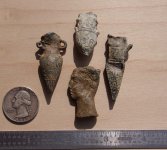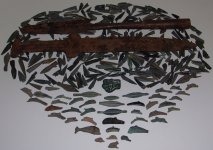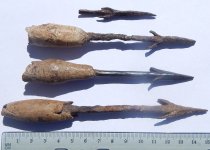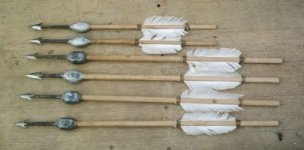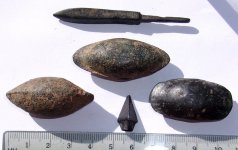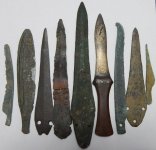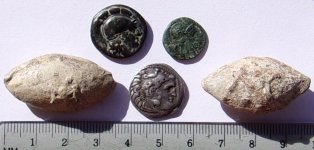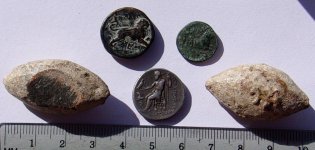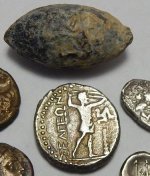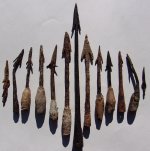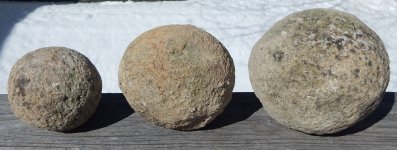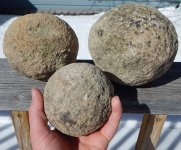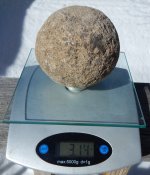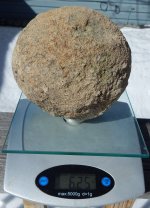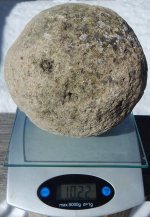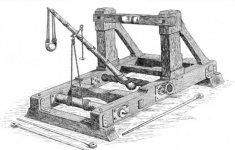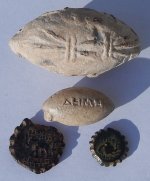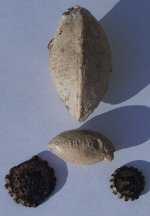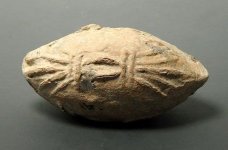Plumbata
Bronze Member
As most of us here I have many hobbies and collections, but the richest and most personally interesting realm of research and collecting is antiquities from ancient European cultures and civilizations, spanning Paleolithic tools of the Neanderthals through melee weapons from the 17th century. I was in 8th grade when I first saw "The Gladiator" and was infected with a deep desire to own an ancient Roman spearhead, which began my voyage down the rabbit-hole of the magnificent world of ancient treasures and their historical context and implications.
From crude stone hand-axes used to reach the marrow in the bones of ancient extinct beasts to Hungarian battle-axes used to reach the brains of their invading Muslim foes, holding the items unlock a vast wealth of awe-inspiring historical reality, and connects you to the tangible truth of the men and women who held and used that same item on the other side of the misty shroud of Time. Those individuals, though their names have been lost and faces forgotten, lived and loved and dreamed and struggled and died, and were just as real as you or I. Perhaps far more real even, compared to the decadent and purposeless lives so many suffer through now. They at least had a mission and purpose; to invest their blood, sweat and tears into the foundation of the modern world! With their humble stone tools they slowly learned how to tame land and beast, discovering agriculture, animal husbandry, and then began to dabble in the magic of Metallurgy.
When humanity mastered the metallurgical arts, we were launched on an unstoppable trajectory to the awesome wonders of the modern day. The continuum from a pointy rock to the Space Station is a clear progression of human mastery through the long march of time, with different items from different eras representing the stepping-stones of progress our species has created and then moved forward upon. Small notes in a beautiful symphony as old and complex and dynamic as our whole extraordinary species.
Touching the same surface held by one of our collective ancestors is like shaking hands with those who created and lit the gleaming torch of Civilization. It is upon their backs that the modern day has been built, and I'd like to think I honor them, whoever they were, by preserving and pondering the material traces of their lives.
~~~~~~~~~~
First up are 2 great prizes, the one on the right being a Middle Bronze Age (~3,200 years old) riveted dagger with original bone handle, found in the boggy, tannin-rich anoxic river muck excavated from a construction project on The Rukin in Amsterdam. Such conditions are excellent for preserving bone, and don't allow for the generation of the more stereotypical green bronze patina. It's blade was cracked in antiquity, perhaps a "ritual sacrifice" of the dagger, or perhaps the mundane cause of it being discarded by the transitory Bronze-Age inhabitants of the area (though doubtful, as it would still have been very valuable). It is scribed (not stamped) with an "evil eye" symbol on both sides, and exhibits lovely graceful curves of blade and handle.
The other is a Late Bronze Age knife (~2,800 years old), found in a near the Danube river in Northwest Bulgaria, and likewise retains the majority of its original bone handle, though some of the bottom was not preserved. The handle was clearly lathe-turned and conical/cylindrical, and bears simple decoration which is quite charming.
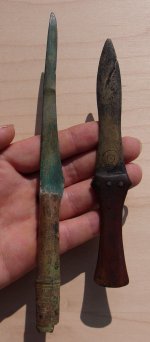
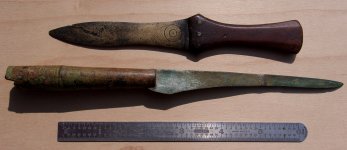
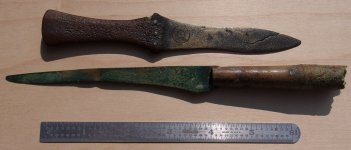
Next are some ancient Sling Bullets, projectiles used in war and launched using the "shepherd's sling" (i.e. David vs Goliath sling). The first projectiles were stone, but then more uniform baked clay projectiles were developed, followed by devastating cast lead bullets, and then my own arcane specialty; the Bi-metallic lead/bronze and solid bronze bullets with sharpened blades; extremely rare and wickedly deadly relative to the already deadly blunt lead bullets.
Many have embossed inscriptions (both insults and indications of loyalty/origin of the launchers) and images, such as scorpions, lightning bolts, snakes etc. to symbolize the stinging/striking/biting of the enemy.
My bullets range between a trifling 18 grams to a crushing 147 grams. If we say that the velocity upon release is 250FPS, the largest bullet would have 426.8 Joules of kinetic energy, compared to 245 joules for a .380 round or 467 joules for a 9mm. At 300fps, which I fully believe was achievable by professional slingers, you get 615 joules, not far behind a .357 mag at 672 joules.
The main difference between the small fast modern bullets and the slower larger bullets of antiquity is that a modern bullet may well pass right through, whereas a sling bullet would transfer all its energy into the victim; crushing bones and rupturing organs even if it doesn't penetrate. Fearsome enough just as a lump of lead, but truly terrifying when the bullets are upgraded with razor-blades and wielded by marksmen who can hit a face-sized target at 50-100 yards!
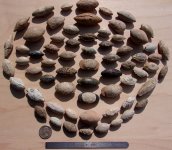
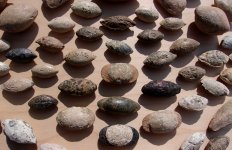
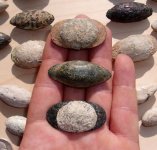
The Bi-metallic bullets, with a lead core cast around the bronze blade section, are only known from the island of Cyprus and even there are extraordinarily rare. I found 2 referenced in museum collections on the island in some obscure archaeological articles, and with 4 in possession (quite a story in itself) I probably have the largest accumulation of such rarities in either private or institutional hands in the world. I think they date from the early 5th century BC.
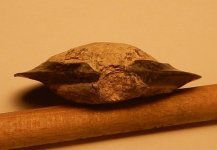
Much much more to come!
From crude stone hand-axes used to reach the marrow in the bones of ancient extinct beasts to Hungarian battle-axes used to reach the brains of their invading Muslim foes, holding the items unlock a vast wealth of awe-inspiring historical reality, and connects you to the tangible truth of the men and women who held and used that same item on the other side of the misty shroud of Time. Those individuals, though their names have been lost and faces forgotten, lived and loved and dreamed and struggled and died, and were just as real as you or I. Perhaps far more real even, compared to the decadent and purposeless lives so many suffer through now. They at least had a mission and purpose; to invest their blood, sweat and tears into the foundation of the modern world! With their humble stone tools they slowly learned how to tame land and beast, discovering agriculture, animal husbandry, and then began to dabble in the magic of Metallurgy.
When humanity mastered the metallurgical arts, we were launched on an unstoppable trajectory to the awesome wonders of the modern day. The continuum from a pointy rock to the Space Station is a clear progression of human mastery through the long march of time, with different items from different eras representing the stepping-stones of progress our species has created and then moved forward upon. Small notes in a beautiful symphony as old and complex and dynamic as our whole extraordinary species.
Touching the same surface held by one of our collective ancestors is like shaking hands with those who created and lit the gleaming torch of Civilization. It is upon their backs that the modern day has been built, and I'd like to think I honor them, whoever they were, by preserving and pondering the material traces of their lives.
~~~~~~~~~~
First up are 2 great prizes, the one on the right being a Middle Bronze Age (~3,200 years old) riveted dagger with original bone handle, found in the boggy, tannin-rich anoxic river muck excavated from a construction project on The Rukin in Amsterdam. Such conditions are excellent for preserving bone, and don't allow for the generation of the more stereotypical green bronze patina. It's blade was cracked in antiquity, perhaps a "ritual sacrifice" of the dagger, or perhaps the mundane cause of it being discarded by the transitory Bronze-Age inhabitants of the area (though doubtful, as it would still have been very valuable). It is scribed (not stamped) with an "evil eye" symbol on both sides, and exhibits lovely graceful curves of blade and handle.
The other is a Late Bronze Age knife (~2,800 years old), found in a near the Danube river in Northwest Bulgaria, and likewise retains the majority of its original bone handle, though some of the bottom was not preserved. The handle was clearly lathe-turned and conical/cylindrical, and bears simple decoration which is quite charming.



Next are some ancient Sling Bullets, projectiles used in war and launched using the "shepherd's sling" (i.e. David vs Goliath sling). The first projectiles were stone, but then more uniform baked clay projectiles were developed, followed by devastating cast lead bullets, and then my own arcane specialty; the Bi-metallic lead/bronze and solid bronze bullets with sharpened blades; extremely rare and wickedly deadly relative to the already deadly blunt lead bullets.
Many have embossed inscriptions (both insults and indications of loyalty/origin of the launchers) and images, such as scorpions, lightning bolts, snakes etc. to symbolize the stinging/striking/biting of the enemy.
My bullets range between a trifling 18 grams to a crushing 147 grams. If we say that the velocity upon release is 250FPS, the largest bullet would have 426.8 Joules of kinetic energy, compared to 245 joules for a .380 round or 467 joules for a 9mm. At 300fps, which I fully believe was achievable by professional slingers, you get 615 joules, not far behind a .357 mag at 672 joules.
The main difference between the small fast modern bullets and the slower larger bullets of antiquity is that a modern bullet may well pass right through, whereas a sling bullet would transfer all its energy into the victim; crushing bones and rupturing organs even if it doesn't penetrate. Fearsome enough just as a lump of lead, but truly terrifying when the bullets are upgraded with razor-blades and wielded by marksmen who can hit a face-sized target at 50-100 yards!



The Bi-metallic bullets, with a lead core cast around the bronze blade section, are only known from the island of Cyprus and even there are extraordinarily rare. I found 2 referenced in museum collections on the island in some obscure archaeological articles, and with 4 in possession (quite a story in itself) I probably have the largest accumulation of such rarities in either private or institutional hands in the world. I think they date from the early 5th century BC.

Much much more to come!



